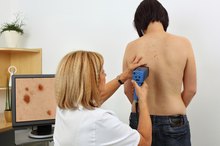Ear Signs of Skin Cancer
Skin cancer often develops on sun-exposed areas of the body, including the ears as well as the face, neck, chest, hands, arms and legs. Skin cancer that develops on the ear can take various forms. Although fair-skinned people have a higher risk of skin cancer, people of all skin tones may be affected, MayoClinic.com notes 1. Skin cancers may be easier to spot on the face or chest, but simple examination of the ears helps avoid problems from this treatable condition.
Basal Cell Signs
Basal cell carcinoma, the most common type of skin cancer, may affect the ears. It may appear as a flesh-colored, pearl-like bump or a pink patch of skin, according to the American Academy of Dermatology. The marks may also appear as flat or brownish lesions. It usually takes a long time for basal cell carcinomas to grow or spread to other parts of the body. People who find these suspicious spots should see a doctor for examination or prompt treatment. Although it grows slowly, basal cell carcinoma can invade surrounding tissues and get into nerves and bone, leading to possible damage and disfigurement. Doctors can easily remove basal cell carcinomas, usually in the office, when treated early.
- Basal cell carcinoma, the most common type of skin cancer, may affect the ears.
- Although it grows slowly, basal cell carcinoma can invade surrounding tissues and get into nerves and bone, leading to possible damage and disfigurement.
Squamous Cell Signs
Types of Skin Cancer on the Nose
Learn More
Squamous cell carcinomas may develop on the ears. Squamous cell cancer, the second most common type of skin cancer, may appear as reddish, hard bumps or scaly patches. They may look like ulcers that heal and open again or develop as flat lesions with crusted surfaces. Basal cell carcinomas can grow deep in the skin and threaten to damage or disfigure skin tissue. Early treatment prevents the spread and damage.
- Squamous cell carcinomas may develop on the ears.
- Squamous cell cancer, the second most common type of skin cancer, may appear as reddish, hard bumps or scaly patches.
Melanoma Signs
Melanoma, the deadliest form of skin cancer, can appear anywhere on the body, including the ears 2. Sun exposure may not even play a role in the development of this cancer. Examination by a doctor is essential for people who notice suspicious moles, spots or growths. Advances in medical techniques have bettered the prognoses for those with melanoma, as long as treatment begins early. The Skin Cancer Foundation recommends the ABCDE method of spotting melanoma 2. This method refers to asymmetry, border, color, diameter and evolving when looking for warning signs. Melanoma may appear asymmetrical with half of a mole looking different than the other half. Growths that have uneven or notched borders may signal melanoma. A mole may vary in color, being brown, black, red or blue. Melanomas are usually more than ¼-inch in diameter, or larger than the size of a pencil eraser. Moles that evolve and change in size, shape or color, or start bleeding or crusting indicate melanoma.
- Melanoma, the deadliest form of skin cancer, can appear anywhere on the body, including the ears 2.
- Moles that evolve and change in size, shape or color, or start bleeding or crusting indicate melanoma.
Related Articles
References
- MayoClinic.com: Skin Cancer-Symptoms
- Skin Cancer Foundation: The ABCDEs of Melanoma
- PDQ Adult Treatment Editorial Board. Skin Cancer Treatment (PDQ®): Patient Version. In: PDQ Cancer Information Summaries [Internet]. Bethesda (MD): National Cancer Institute (US); 2002-. Published online April 9, 2019.
- American Society of Clinical Oncology. Melanoma: Symptoms and Signs. Updated January 2019.
- Daniel Jensen J, Elewski BE. The ABCDEF rule: Combining the "ABCDE rule" and the "ugly duckling sign" in an effort to improve patient self-screening examinations. J Clin Aesthet Dermatol. 2015;8(2):15.
- Jovanovic P, Mihajlovic M, Djordjevic-jocic J, Vlajkovic S, Cekic S, Stefanovic V. Ocular melanoma: an overview of the current status. Int J Clin Exp Pathol. 2013;6(7):1230-44.
- Ocular Melanoma Foundation. About Ocular Melanoma.
- Bristow IR, De berker DA, Acland KM, Turner RJ, Bowling J. Clinical guidelines for the recognition of melanoma of the foot and nail unit. J Foot Ankle Res. 2010;3:25. doi:10.1186/1757-1146-3-25
- Oakley A. Melanoma of nail unit. DermNet NZ. 2011.
- McDaniel B, Badri T. Basal Cell Carcinoma. In: StatPearls [Internet]. Treasure Island (FL): StatPearls Publishing; 2019.
- Jaafar S, Jestila T, Waheed A, Misra S, Thakkar D. Synchronous non-collision melanoma and basal cell carcinoma arising from chronic lymphedema: a case report and review of literature. J Surg Case Rep. 2019;2019(4):rjz105. doi:10.1093/jscr/rjz105
- Howley EK. Skin cancer: Melanoma, basal cell, squamous cell carcinoma. U.S. News and World Report. February 19, 2019.
- American Society of Clinical Oncology. Skin Cancer (Non-Melanoma): Symptoms and Signs. Updated January 2018.
- Weller, Richard P. J. B., Hamish J.A. Hunter, and Margaret W. Mann. Clinical Dermatology. Chichester (West Sussex): John Wiley & Sons Inc., 2015. Print.
Writer Bio
Jerry Shaw writes for Spice Marketing and LinkBlaze Marketing. His articles have appeared in Gannett and American Media Inc. publications. He is the author of "The Complete Guide to Trust and Estate Management" from Atlantic Publishing.









